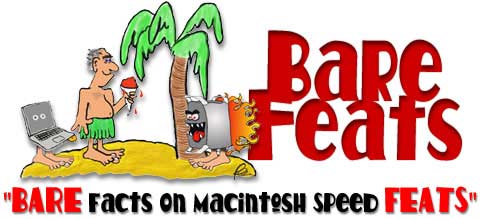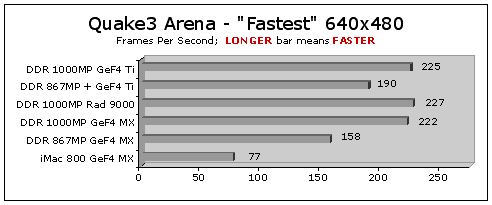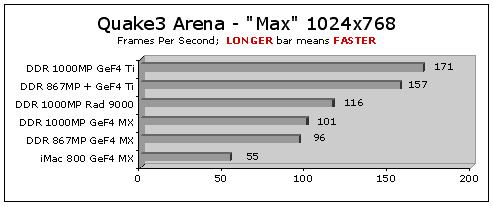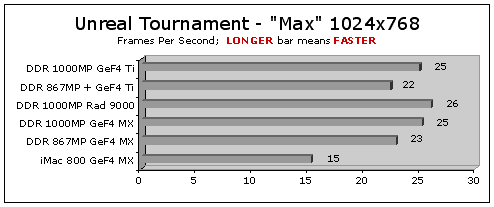
 SmallDog.com
has refurbished
towers, laptops, displays, etc., with 12 month
warranty.
SmallDog.com
has refurbished
towers, laptops, displays, etc., with 12 month
warranty.
Page TWO -- Games, Graphics |
|
Originally
posted 8/26/02 Continuing on our quest for the "BEST BUY" in a G4 Power Mac, let's look at things from a gamer's point of view. Is the 1000MP that much faster than the 867MP? If you get an 867MP with the optional 128MB GeForce4 Titanium, will it be just as fast as the 1000MP with a Radeon 9000? Or is the iMac G4/800 with GeForce4 MX just as fast? We finally got a DDR Power Mac 1000MP in the local lab and tested it with three different graphics cards. And we tested the DDR Power Mac 867MP with both the GeForce4 MX and GeForce4 Titanium. LEGEND for GRAPHS: Rad 9000 = Radeon 9000, GeF4 MX = GeForce4 MX, GeF4 Ti = GeForce4 Titanium

As you can see, when texture detail and geometric detail are set to maximum, the GeForce4 Titanium provides a significant boost to frame rates in Quake3 Arena. And the 867MP with the GeForce4 Ti beats the 1000MP with Radeon 9000. But I'm hesitant to recommend that you spend $250 to $400 on the best graphics card when most games for the Mac are CPU bound rather than graphics bound. Take a look at the results from Unreal Tournament below. As you can see, the graphics card choice has little to do with the frame rate, even at max quality textures. And having dual CPU's doesn't help either. Most games are like Unreal Tourney. The game is no faster than the fastest single CPU.
CONCLUSION Unless you are an obsessive speed freak like me, get the Power Mac with the default graphics card. Save your money for adding memory and faster/bigger hard drives from bargain third party sources. Gamers should buy the fastest CPU they can afford. (Bargain minded gamers should consider the "closeout" G4/933 selling for $1400 from various sources. It would be faster than the 867MP for most games.) If you are a Quake3 Arena fanatic and want more frames per second, you can save hundreds of dollars by upgrading to a GeForce3 or Radeon 8500. Those "obsolete" but fast graphics cards are available from outlets like MacResQ, Other World Computing, MacGurus and Buy.Com. There are other reasons to add a "deluxe" graphics card like GeForce4 Titanium or the soon to be released Radeon 9700. Both cards provide 128MB's of video memory which helps if you are running 3D apps on dual displays at high resolution. The GeForce4 Ti comes with one ADC connector and one DVI connector. So it doesn't cost you an arm and a leg to connect dual ADC LCD displays.
RELATED LINKS Read about what Apple has to say about the nVIDIA GeForce4 Titanium on the GRAPHICS page of the Power Mac section. It includes an interesting graph showing the relative speed of the three DDR Power Macs running Quake3 Arena. (It looks like they were running at "High Quality" instead of "Max Quality" like I use. Regardless, the 1.25GHz DDR Power Mac is only 13% faster than the 1GHz DDR Power Mac!) See nVIDIA's specs on the GeForce4 Titanium. (Apple's card is comparable to the 4600 chip set.) ATI has a description page for the Radeon 8500 Mac Edition and Radeon 9000 Mac Edition on their site. Anandtech compares the Radeon 9000 to the 8500, GeForce4 MX, and GeForce4 Titanium AGP cards for Windows PC's. They also compare the Geforce4 Go to the Radeon 9000 Mobility (both are NEW chips for laptops.) Read about the new Radeon 9700 (Mac Edition coming in a few months), which, according to Anandtech.com's tests, is 30 to 50% faster than the GeForce4 Titanium... at least when run on a Windows PC.
TEST NOTES The "SDR" Power
Mac 1GHz MP had 1GB of PC133 CL2 SDRAM. Graphics cards
used: For details on each real world test, read "HOW I TEST." |
HOME PAGE
SPEED TEST RESULTS by Category
LINKS to SPEED tests on other sites
HOT DEALS on speed upgrades
rob-ART
morgan,
mad scientist and webmaster

Has Bare Feats helped you? Say "thanks"... with a donation.
"BARE facts on Macintosh speed FEATS"
Email webmaster at rob-art@barefeats.com
(Bare Feats is hosted on a G4 Power Mac server by MacDock.com)

Has Bare Feats helped you? Say "thanks"... with a donation.


